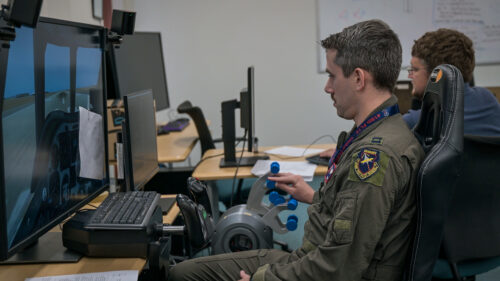A dedicated team of experts from the Global Power Bombers Combined Test Force has embarked on an ambitious journey to enhance the B-52 Stratofortress’ flight instrumentation due to the B-52 Stratofortress Commercial Engine Replacement Program (CERP). As part of this endeavor, the team is delving into the realm of human factors integration, aiming to equip air crews with advanced tools to navigate and control this legendary bomber more effectively.

U.S. Air Force photo by Giancarlo Casem
The CERP program, which recently selected Rolls-Royce North America to supply its powerplant, is poised to extend the lifespan of the B-52 Stratofortress while bolstering its capabilities for the next three decades. The chosen engine, the American-made Rolls-Royce F-130 have accumulated over 27 million engine flight hours across various platforms.
The heart of the CERP program lies in its commitment to seamlessly integrate the F-130 engine with the B-52, ensuring a robust synergy between powerplant and airframe. This intricate task is backed by the relentless efforts of the Global Power Bombers Combined Test Force team, which has now shifted its focus to the pivotal aspect of human factors integration.
The crux of this phase involves updating the flight instrumentation on the B-52 to match the capabilities of the new engines. This includes deploying state-of-the-art digital gauges, strategically paired with the upgraded engines, to provide flight crews with real-time, critical information during their missions. This collaborative effort between test pilots and engineers aims to identify the optimal gauge cluster that best suits the needs of air crews.
Lt. Col. Scott Pontzer, commander of the 419th Flight Test Squadron and director of GPB CTF, explains, “The team is using an innovative approach to get both quantitative and qualitative data to take a look at what is the best picture of how to manage the eight engines on a B-52 for the warfighter.” This proactive approach seeks to streamline the management of the aircraft’s multiple engines and, in turn, enhance its operational effectiveness.
Essential to the initiative is assessing the readability and usability of these gauges. The team is meticulously evaluating how effectively human operators can interact with throttle positions and interpret any anomalies that might arise. The overarching goal is to equip crews with precise information during critical phases of flight, minimizing workload and contributing to safer and more effective missions.
Maj. Darin Flynn, B-52 test pilot from the 370th Flight Test Squadron, highlights the importance of visualizing the prototypes. Through animated mockups of the real displays, pilots gain valuable insights into the gauges’ functionality and appearance, leading to more informed design choices.
As Dicarie Williamson, Human System Integration Engineer at the Air Force Test Pilot School, underscores, the objective is to create a margin that allows operators to comprehend complex systems swiftly and make well-informed decisions. This approach addresses the challenges of managing intricate systems while navigating thousands of feet above the ground or operating potentially hazardous weapon systems.
The collaboration doesn’t stop with flight crews; the team also aims to engage aircraft maintainers to gather feedback on how the updated digital instrumentation might impact maintenance procedures. This comprehensive approach ensures that the integration of new technologies doesn’t inadvertently introduce complexities to the maintenance process.
For more information, hit the Source below